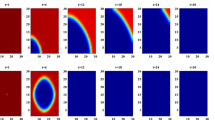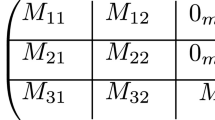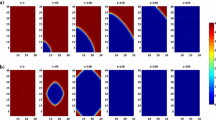Abstract
In this paper, two types of distributed control functions, vaccine and treatment have been applied to a spatiotemporal SIR model with no-flux boundary conditions. The spatiotemporal SIR epidemic model is formulated from existing SIR epidemic model by including a diffusion term in his different compartments to study the impact of spatial heterogeneity of disease transmission in dense regions. Our main objective to find the optimal control pair that minimizes the number of infected individuals, the corresponding vaccination and treatment costs. The existence of the positive solution for the state system and the existence of a distributed optimal control pair are proved. Techniques of optimal control are used to characterize optimal control pair in terms of state and adjoint functions. The optimality system is solved numerically; the numerical results show that the control effect is effective if the treatment and vaccine strategies are used simultaneously.








Similar content being viewed by others
References
Bailey N (1975) The mathematical theory of infectious diseases, 2nd edn. Hafner, New York
Kermack WO, McKendrick AG (1927) A contribution to the mathematical theory of epidemics. In: Proceedings of the royal society of London a: mathematical, physical and engineering sciences, The Royal Society, vol 115, pp 700–721
Ji C, Jiang D, Shi N (2012) The behavior of an sir epidemic model with stochastic perturbation. Stoch Anal Appl 30(5):755–773
Mouaouine A, Boukhouima A, Hattaf K, Yousfi N (2018) A fractional order SIR epidemic model with nonlinear incidence rate. Adv Differ Equ 1:160
El-Saka HAA (2014) he fractional-order SIS epidemic model with variable population size. J Egypt Math Soc 20(1):50–54
Kuznetsov YA, Piccardi C (1994) Bifurcation analysis of periodic SEIR and SIR epidemic models. J Math Biol 32(2):109–121
McCluskey CC (2010) Complete global stability for an sir epidemic model with delay—distributed or discrete. Nonlinear Anal Real World Appl 11(1):55–59
Pathak S, Maiti A, Samanta GP (2010) Rich dynamics of an sir epidemic model. Nonlinear Anal Model Control 15(1):71–81
Song M, Ma W (2006) Asymptotic properties of a revised sir epidemic model with density dependent birth rate and time delay. Dyn Contin Discrete Impulsive Syst Ser A 13(2):199
Jiajia Y, Jiang D, Shi N (2009) Global stability of two-group sir model with random perturbation. J Math Anal Appl 360(1):235–244
Zhang F, Li Z, Zhang F (2008) Global stability of an sir epidemic model with constant infectious period. Appl Math Comput 199(1):285–291
Kramer AM, Pulliam JT, Alexander LW, Park AW, Rohani P, Drake JM (2016) Spatial spread of the West Africa ebola epidemic. R Soc Open Sci 3(8):160294
da Costa ACC, Codeço CT, Krainski ET, da Costa Gomes MF, Nobre AA (2018) Spatiotemporal diffusion of influenza a (h1n1): starting point and risk factors. PloS ONE 13(9):e0202832
Wang X, Posny D, Wang J (2016) A reaction–convection–diffusion model for cholera spatial dynamics. Discrete Contin Dyn Syst Ser B 21:2785–2809
Chinviriyasit S, Chinviriyasit W (2010) Numerical modelling of an sir epidemic model with diffusion. Appl Math Comput 216(2):395–409
Laaroussi AEA, Ghazzali R, Rachik M, Benrhila S (2019) Modeling the spatiotemporal transmission of ebola disease and optimal control: a regional approach. Int J Dyn Control 1–15
Laaroussi AEA, Rachik M, Elhia M (2016) An optimal control problem for a spatiotemporal sir model. Int J Dyn Control 6(1):384–397
Samsuzzoha M, Singh M, Lucy D (2011) Numerical study of a diffusive epidemic model of influenza with variable transmission coefficient. Appl Math Model 35(12):5507–5523
McAsey M, Mou L, Han W (2012) Convergence of the forward–backward sweep method in optimal control. Comput Optim Appl 53(1):207–226
Yusuf TT, Benyah F (2012) Optimal control of vaccination and treatment for an sir epidemiological model. World J Model Simul 8(3):194–204
Klimenkova O (2016) Optimal control for virus spreading for an sir model, arXiv preprint arXiv:1612.08302
Chen L, Sun J (2014) Optimal vaccination and treatment of an epidemic network model. Phys Lett A 378(41):3028–3036
Cui Q, Yang X, Zhang Q (2014) An NSFD scheme for a class of sir epidemic models with vaccination and treatment. J Differ Equ Appl 20(3):416–422
Zaman G, Kang YH, Cho G, Jung IH (2017) Optimal strategy of vaccination and treatment in an sir epidemic model. Math Comput Simul 136:63–77
Ge J, Kim KI, Lin Z, Zhu H (2015) A sis reaction–diffusion-advection model in a low-risk and high-risk domain. J Differ Equ 259(10):5486–5509
Laarabi H, Abta A, Hattaf K (2015) Optimal control of a delayed sirs epidemic model with vaccination and treatment. Acta Biotheor 63(2):87–97
Vrabie Ioan I (2003) C0-semigroups and applications, volume 191 of North-Holland Mathematics Studies, North-Holland Publishing Co., Amsterdam
Smoller J (2012) Shock waves and reaction–diffusion equations, vol 258. Springer, Berlin
Brezis H, Ciarlet PG, Lions JL (1999) Analyse fonctionnelle: théorie et applications, vol 91. Dunod, Paris
Barbu V (2012) Mathematical methods in optimization of differential systems, vol 310. Springer, Berlin
Pazy A (2012) Semigroups of Linear Operators and Applications to Partial Differential Equations, vol 44. Springer, Berlin
Acknowledgements
The authors would like to thank all the members of the Editorial Board who were responsible of this paper, and the anonymous referees for their valuable comments and suggestions to improve the content of this paper.
Author information
Authors and Affiliations
Corresponding author
Appendix
Appendix
First recall a general existence result which we use in the sequel (Proposition 1.2, p. 175, [30]; see also [27, 31]). Consider the initial value problem
where A is a linear operator defined on a Banach space X, with the domain D(A) and \(g:[0,T]\times X\rightarrow X\) is a given function. If X is a Hilbert space endowed with the scalar product \((\cdot ,\cdot )\), then the linear operator A is called dissipative if \((Ay,y)\le 0,\,\left( \forall y\in D(A)\right) \).
Theorem 5
X be a real Banach space, \(A:D(A)\subseteq X\rightarrow X\) be the infinitesimal generator of a \(C_{0}-\) semigroup of linear contractions \({S(t),\,t\ge 0}\) on X, and \(g:[0,T]\times X\rightarrow X\) be a function measurable in t and Lipschitz continuous in \(x\in X\), uniformly with respect to \(t\in [0,T]\).
(i) If \(y_{0}\in X\), then problem (36) admits a unique mild solution, i.e. a function \(y\in C([0,T];X)\) which verifies the equality \(y(t)=S(t)y_{0}+\int _{0}^{t}S(t-s)g(s,y(s))ds, (\forall t\in [0,T])\).
(ii) If X is a Hilbert space, A is self-adjoint and dissipative on X and \(y_{0}\in D(A)\), then the mild solution is in fact a strong solution and \(y\in W^{1,2}(\left[ 0,T\right] ;X)\cap L^{2}(0,T;D(A))\)
Rights and permissions
About this article
Cite this article
Ghazzali, R., Laaroussi, A.E., EL Bhih, A. et al. On the control of a reaction–diffusion system: a class of SIR distributed parameter systems. Int. J. Dynam. Control 7, 1021–1034 (2019). https://doi.org/10.1007/s40435-019-00553-6
Received:
Accepted:
Published:
Issue Date:
DOI: https://doi.org/10.1007/s40435-019-00553-6




